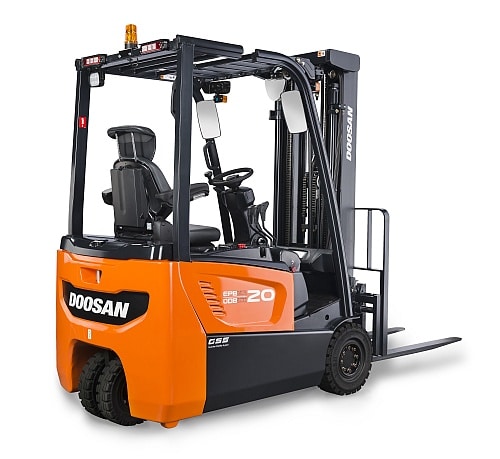As the world develops and business expands into new and untapped markets, the demand for well-managed warehouse space will only increase at an exponential rate. And as demand increases, so to will the need for vehicles which are able to navigate warehouse spaces and ensure the proper logistical procedures are followed.
The vehicles at the heart of this effort are of course the forklifts that have been synonymous with warehouses since the very development of modern industry. Since their development at the start of the 21st century, these relatively simple machines have revolutionised the way we handle storage space, enabling us to undertake logistical operations smoothly and efficiently. From the first basic models to the varied and task-specific vehicles available on the market today, we will take a brief look at the variety of machines commonly used in a warehouse setting and consider their benefits.
History
The sleek, modern, chrome-covered forklifts that we see today began their history as little more than battery-powered hoist platforms, used to haul cargo at railway depots. The impetus to develop the technology’s potential only came about as a result of World War I, when manpower shortages forced manufacturers to come up with new innovations to help mitigate the lack of available labour. The first battery-powered, steel-made lift truck was created by Ransomes, Sims & Jeffries, an Ipswich-based company. The vehicle, the first of its kind, allowed loads to be moved both horizontally and vertically.
During the interwar years that followed, a number of developments went into creating a version of the forklift that we know today, including the introduction of a standardised format of pallets which lead to the creation of the instantly recognizable “fork” style lift, and the addition of hydraulic power to the machinery. By the time the Second World War rolled along, the predecessor to what we would designate as the modern forklift was in operation all over the world.
Form and function
The basic principles behind the forklift are relatively simple. The vehicle has to have some form of power-operated forked or otherwise platform attached at the front, which is inset beneath cargo and can then be raised, lowered or some cases extended forward. All of this is achieved with a lift handle, attached to an electric air pump at the base of the vehicle.
Pressing the handle triggers the air pump to draw in outside air, process it through a filter, and force it into a tube which reaches the hydraulic cylinders. These hydraulic cylinders are hollow tubes, closed at one end, fitting into each other thanks to a flexible lubricated piston. Gas in this cylinder raises the internal pressure, which is in turn applied to the piston head, generating an upward force. Pistons then move up, increasing the gas volume and reducing the pressure which enables physical equilibrium to be achieved at the forklift’s height with an equivalent force from the gas and forklift load. The vehicle itself is powered either by an electric battery or a combustion engine, with some models requiring the operator to sit, others to stand.
UK requirements mandate that forklift drivers be able to pass a number of criteria before they are legally permitted to operate any kind of forklift. These include:
– Forklift Training; the primary component for operating a forklift in the UK is the possession of an in-date certificate of completion for a Forklift Training Course, accredited to either the RTITB, ITSAAR, ALLMI, NPORS or AITT – due to the potentially dangerous nature of the work, companies will usually require any candidates possess certification from a credible training institute
– Due to Health and Safety Regulations, all drivers must be a minimum age of 18
– Forklift drivers must be of a sufficient standard of health in order to operate the vehicle without posing a danger to themselves or others around them, which sometimes necessitates new candidates take a medical exam
– A driver’s licence may be required if the forklift is going to be operating on or near public roads
Although forklifts can be used in a variety of different capacities, from airports to the food production industry, for the purposes of this article we will be focusing on the most common environment you are likely to see forklifts being used, namely, warehouses, and the different types of forklifts most beneficial for use in this environment.
Types of warehouse forklifts
There are a number of different ways forklifts can be used in a warehouse setting. They load and unload delivery or mover trucks, carry goods between spots, stack them, place them on shelving, among other things. Warehouses can vary wildly in terms of size and capacity, and to reflect this, an extensive range of forklifts has been developed over the years by the industry to include everything from pedestrian operated machines to heavy-duty driver operates vehicles. There is a great deal of variance in terms of sizes, with the average one-ton capacity forklift suited to general warehouse related work to the immense 50-ton capacity machines more suited to working around shipping containers. Listed below are just a few of the most common examples of warehouse forklifts;
Pallet truck
Doubtless the most common variant of forklift on this list, pallet trucks are a staple feature in everything from the backrooms of retail outlets to industrial-scale warehouses. Used primarily for loading and unloading goods that are delivered on pallets, a pallet truck, also known as a pump truck or pallet jack, is a wheeled trolley-like platform designed primarily to lift and move pallets. It is the easiest “forklift” to use as its primary fuel source is human effort, and so does not require any special training to manage.
Order picker
Not quite a forklift in the common sense of the word, an order picker is used to move its operator vertically up and down a rack with or without a load. They are designed in such a way to allow the operator to be on the same level as the goods they are moving, allowing the user to move them by hand. Usually, goods will be individually packaged, and will not require heavy machinery to move.
Counterbalance forklift
When it comes to the mechanised handling of materials, the counterbalance forklift is the most common piece of equipment you are likely to find in a warehouse setting. Its main characteristics are a pair of load-bearing forked blades. There are no outrigging legs or arms on this variant, meaning it is possible to drive the vehicle right up to the location of the load or racking.
3 wheel forklift
The most obvious feature of this variant is the fact that it operates on only three wheels, as opposed to the counterbalance’s four. Used to navigate narrow aisles and tight space, their manoeuvrability can benefit operations to a point, but the downside is that they possess a lighter load capacity, usually not much more than 2500kg.
Forklift stacker
The primary purpose of this forklift, unsurprisingly, is to lift loads to a high altitude. They are ideally suited to any situation in which storage has to be placed at a great height on a shelving system.
Electric forklift
At first glance, electric skids seemed to be little more than an automated version of the pallet truck. In truth, electric forklifts or skids represent a modern take of traditional hydraulics, replicating the original function of the hydraulic skid.
Forklift side loader
This variant is designed to navigate narrow corridors. Its blades are mounted on the side of the platform so that it can lift loads along or across, which would be an impractical ask for the common counterbalance forklift. The downside of the course being they are unsuited to normal forklift tasks.
Telescopic forklift
One of the more complex variants, this forklift is for users to who need to lift loads at heights or store in mezzanines. Not dissimilar to a crane, they are able to reach heights and angles that other forklifts would not be able to access
Overall benefits
As has been demonstrated, there exist as many variants of forklift as there are conceivable uses for them. When considering the overall use of the forklift in a warehouse setting and how they can improve the logistics and smooth running of your operation, there are three key benefits to consider:
Safety
Before forklifts were widely available, all heavy lifting and moving had to be done by hand or using unwieldy technology. The danger inherent in the use of these methods, and therefore there is an obvious argument to be made that since the inception of forklifts, worker safety has increased, reducing workplace accidents and environmental injuries.
Manoeuvrability and load capacity
Following on from this, forklifts represent a significant improvement over the use of manual labour based due to their efficiency and capacity. Forklifts can achieve far more than even twenty men might achieve and do so in far less time. The loads they carry, which depending on the forklift can exceed 31’000 kilograms, allow you to perform tasks that would otherwise be impossible to do. And added to this, they are relatively easy to use, require small amounts of storage space, and in the long term will cost less to maintain than the equivalent in human labour.
Variants
At the risk of repeating the previous sections, the sheer number of forklift variants is a benefit in of itself. No matter what task you might have in mind or what requirements you need to fulfil, chances are you will be able to find some form of forklift that will meet your needs. Contact us to discuss your warehouse needs and how we can help you with your fleet.


